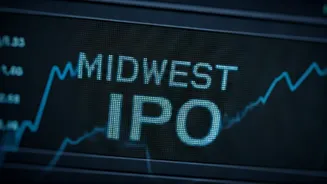IPO's Major Highlights
The Midwest IPO garnered attention, and various key elements came into focus. The GMP, or Grey Market Premium, played a crucial role in the financial market's
sentiment. Information on the listing date and price were also central to the discourse, allowing prospective investors to determine the financial value. Accessibility of information, such as price and lot sizes, was streamlined via online portals. Simultaneously, details concerning allotment were announced, as they are crucial for those who have invested or are planning to invest in the IPO. Moreover, the process of checking the allotment status was made accessible via user-friendly platforms to improve transparency and accessibility.
GMP's Role Examined
Grey Market Premium (GMP) served as a vital indicator within the Midwest IPO context, giving preliminary signals about listing day performance. It essentially showed what market participants were willing to pay for the shares prior to their official trading debut on the stock exchange. The GMP could fluctuate considerably, reflecting investor sentiment and expectations about the IPO's performance. The figures concerning GMP indicated market perceptions and potential success or failure of the IPO. Changes in GMP values were closely monitored as they provided early insights into the IPO's potential market performance. For investors and market analysts, GMP figures formed a central focus to evaluate prospects.
Listing Date Insight
The listing date was the highly anticipated day when the Midwest IPO shares officially began trading on the National Stock Exchange (NSE). This event marked the transition of the shares from the primary market (where the IPO was initially offered) to the secondary market, where they could be traded among investors. The listing date's announcement was important as it permitted investors who had been allocated shares to actively trade them, which determined their initial trading value based on market dynamics. The setting of this date triggered a period of trading, in which investors could realize profits or face losses based on share performance. The announcement of the listing date marked the IPO process's completion.
Price and Lot Size
The price of the Midwest IPO shares and the corresponding lot size were crucial elements for investors to understand the financial commitments involved in participating in the IPO. The price point determined the cost per share, which, multiplied by the number of shares in each lot, defined the minimum investment needed. Lot size represented the batch of shares that investors were required to apply for, dictating investment volume. Availability of these figures made the process transparent and simple for potential investors. These figures gave investors the knowledge to gauge affordability and potential returns. Both factors greatly influenced decisions regarding investment, shaping the number of shares people chose to apply for during the IPO process.
Allotment Status Check
The process of verifying the Midwest IPO allotment status was made accessible via diverse digital platforms. Investors could easily check whether they had been allocated shares. This usually required visiting the official website of the registrar, like Kfin Technologies, or the NSE's website, or other online portals specifically designed to manage IPO allotments. Investors needed to input required details, like their application number, PAN number, or Demat account number, to confirm allotment. Once the data was provided, the platform would display the allotment status, indicating whether shares were allocated to the investor. Accessing and assessing this status was a major step, providing certainty for investors and guiding their following steps, such as trading or holding the shares.














